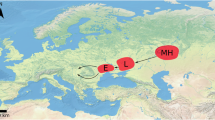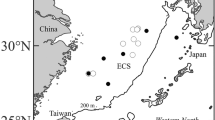Abstract
A chromosome study was carried out on a number of European and Central Asiatic diploid green toad populations by means of standard and various other chromosome banding and staining methods (Ag-NOR-, Q-, CMA3-, late replicating [LR] banding pattern, C- and sequential C-banding + CMA3 + DAPI). This study revealed the remarkable karyological uniformity of specimens from all populations, with the only exception being specimens from a Moldavian population, where one chromosome pair was heteromorphic. Though similar in shape, size and with an identical heterochromatin distribution, the difference in the heteromorphic pair was due to a large inverted segment on its long arms. This heteromorphism was restricted to females, suggesting a female heterogametic sex chromosome system of ZZ/ZW type at a very early step of differentiation.
Similar content being viewed by others
References
Bull J J 1983 Evolution of sex determining mechanisms (London and Amsterdam: Benjamin Cummings)
Eggert C 2004 Sex determination: the amphibian models; Reprod. Nutr. Dev. 44 539–549
Frost D R, Grant T, Faivovich J and Bain R H et al 2006 The amphibian tree of life; Bull. Am. Mus. Nat. Hist. 297 1–370
Hayes T B 1998 Sex determination and primary sex differentiation in amphibians: genetic and developmental mechanisms; J. Exp. Zool. 281 373–399
Howell W M and Black D A 1980 Controlled silver staining of nucleolus organiser regions with a protective colloidal developer: 1-step method; Experientia. 36 1014–1015
Jones K W 1984 The evolution of sex chromosomes; in Chromosomes today Vol 8. (eds) M D Bennett, A Gropp and U Wolf (Hemel Hempstead, England: George Allen and Unwin) pp 241–255
Jones K W 1991 Sex genes and chromosome inactivation; in Symposium on the evolution of terrestrial vertebrates.; Selected symposia and monographs U Z I Vol 4. (eds) G Ghiara, F Angelini, E Olmo and L Varano (Modena, Italy: Mucchi) pp 269–277
King M 1990 Amphibia; in Animal cytogenetics Vol 4. (eds) B John and C Gwent (Berlin: Gebrüder Borntraeger) pp vi+241
Miura I 1995 The late replication banding patterns of chromosomes are highly conserved in the genera Rana, Hyla., and Bufo. (Amphibia: Anura); Chromosoma. 103 567–574
Miura I, Ohtani H, Kashiwagi A, Hanada H and Nakamura M 1996 Structural differences between XX and ZW sex lampbrush chromosomes in Rana rugosa. females (Anura: Ranidae); Chromosoma. 105 237–241
Nishioka M, Hanada H, Miura I and Ryuzaki M 1994 Four kinds of sex chromosomes in Rana rugosa.; Sci. Rep. Lab. Amphibian Biol. Hiroshima Univ. 13 1–34
Nishioka M, Miura I and Saitoh K 1993 Sex chromosomes of Rana rugosa. with special reference to local differences in sex-determining mechanism; Sci. Rep. Lab. Amphibian Biol. Hiroshima Univ. 12 55–81
Odierna G, Aprea G and Capriglione T 1999 Chromosomal and molecular analysis of some repeated families in Discoglossus. Otth, 1837 (Anura, Discoglossidae): taxonomic and phylogenetic implications; It. J. Zool. 66 275–283
Odierna G, Aprea G, Capriglione T, Castellano G and Balletto E 2004 Evidence for chromosome and Pst. I satellite DNA family evolutionary stasis in the Bufo viridis. group (Amphibia, Anura); Chromosome Res. 12 671–681
Ohno S 1967 Sex chromosomes and sex-linked genes. (Berlin: Springer)
Sahar E and Latt S A 1980 Energy transfer and binding competition between dyes used to enhance staining differentation in metaphase chromosomes; Chromosoma. 79 1–28
Schempp M and Schmid M 1981 Chromosome banding in amphibia VI. BrdU-replication patterns in anura and demonstration of XX/XY chromosomes in Rana esculenta.; Chromosoma. 83 697–710
Schmid M 1978 Chromosome banding in amphibia. I. Constitutive heterochromatin and nucleolus organizer regions in Bufo. and Hyla.; Chromosoma. 66 361–388
Schmid M, Steinlein C, Nanda I and Epplen J T 1990 Chromosome banding in amphibia; in Cytogentics of amphibians and reptiles. (ed.) E Olmo (Basel: Birkhäuser) pp 21–45
Schmid M, Nanda I, Epplen J T, Steinlein C, Kausch K and Haaf T 1991 Sex-determining mechanisms and sex chromosomes in amphibia; in Amphibian cytogenetics and evolution. (eds) D M Green and S S Sessions (San Diego, New York, Boston, London, Sydney, Tokyo, Toronto: Academic Press) pp 393–430
Schmid M and Steinlein C 2001 Sex chromosomes, sex-linked genes, and sex determination in vertebrate class amphibia; in Genes and mechanisms in veterbrates sex determination. (eds) G Scheer and M Schmid (Basel: Birkhäuser) pp 143–176
Schmid M, Feichtinger W, Steinlein, Rupprecht A, Haaf T and Kaiser H 2002 Chromosome banding in amphibia. XXIII. Giant W sex chromosomes and extremely small genomes in Eleutherodactylus euphronides. and Eleutherodactylus shrevei. (Anura, Leptodactylidae); Cytogenet. Genome Res. 97 81–94
Stöck M, Steinlein C, Lamatsch D K, Schart M and Schmid M 2005 Multiple origins of tetraploid taxa in the Eurasian Bufo viridis. subgroup; Genetica. 124 255–272.
Sumida M and Nishioka M 1994 Geographic variability of sex-linked loci in the Japanese brown frog Rana japonica.; Sci. Rep. Lab. Amphibian Biol. Hiroshima Univ. 13 173–195
Sumida M and Nishioka M 2000 Sex-linked genes and linkage maps in amphibians; Comp. Biochem. Physiol. B. 126 257–270
Sumner A T 1972 A simple technique for demonstrating centromeric heterochromatin; Exp. Cell Res. 75 304–306
Author information
Authors and Affiliations
Corresponding author
Rights and permissions
About this article
Cite this article
Odierna, G., Aprea, G., Capriglione, T. et al. Cytological evidence for population-specific sex chromosome heteromorphism in Palaearctic green toads (Amphibia, Anura). J Biosci 32, 763–768 (2007). https://doi.org/10.1007/s12038-007-0076-2
Received:
Accepted:
Published:
Issue Date:
DOI: https://doi.org/10.1007/s12038-007-0076-2




